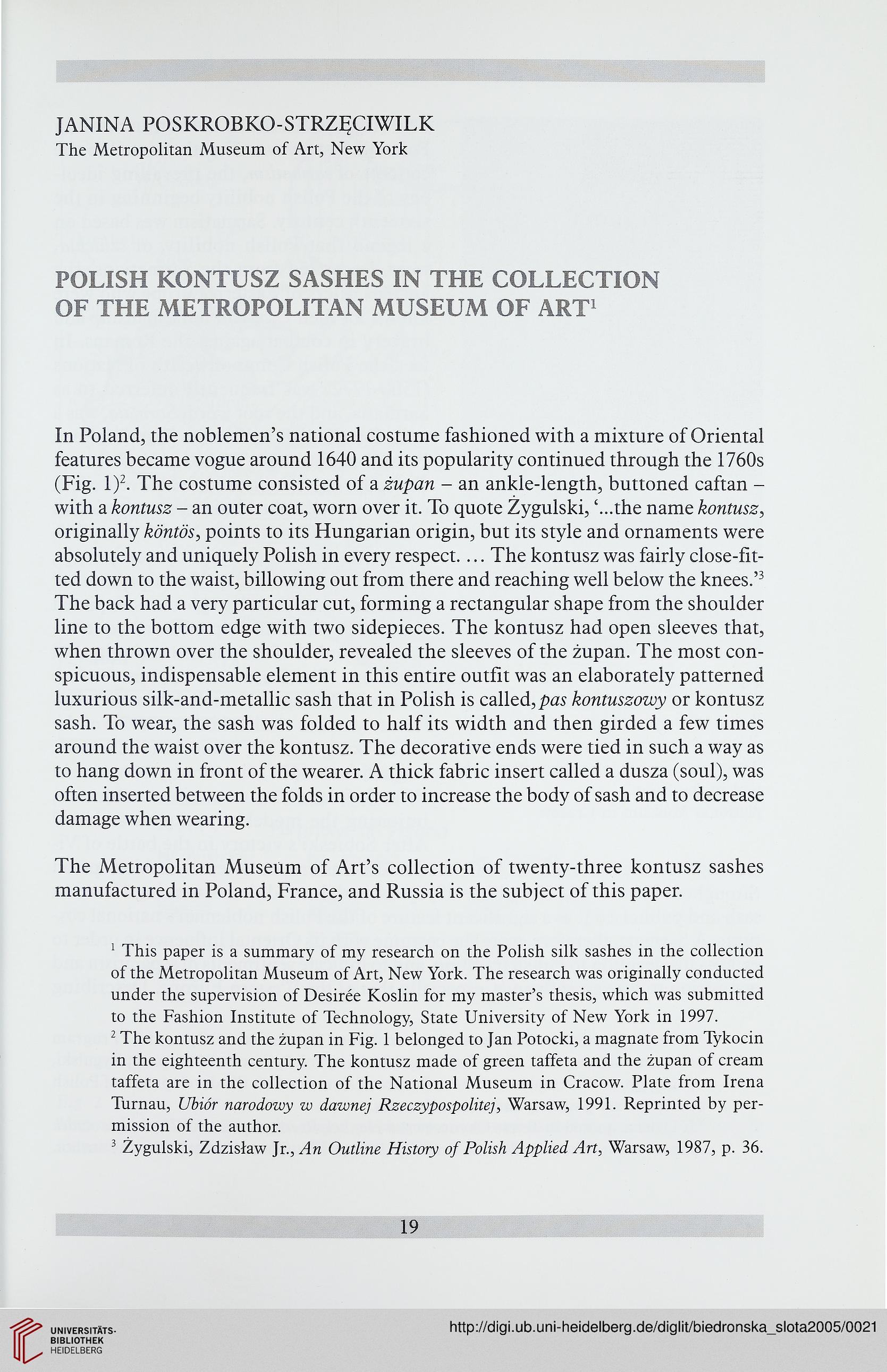mmmmmm
H9HH
JANINA POSKROBKO-STRZĘCIWILK
The Metropolitan Museum of Art, New York
POLISH KONTUSZ SASHES IN THE COLLECTION
OF THE METROPOLITAN MUSEUM OF ART1
In Poland, the noblemen's national costume fashioned with a mixture of Oriental
features became vogue around 1640 and its popularity continued through the 1760s
(Fig. I)2. The costume consisted of a żupan - an ankle-length, buttoned caftan -
with a kontusz - an outer coat, worn over it. To ąuote Zygulski, '...the name kontusz,
originally kóntós, points to its Hungarian origin, but its style and ornaments were
absolutely and uniąuely Polish in every respect.... The kontusz was fairly close-fit-
ted down to the waist, billowing out from there and reaching well below the knees.'3
The back had a very particular cut, forming a rectangular shape from the shoulder
line to the bottom edge with two sidepieces. The kontusz had open sleeves that,
when thrown over the shoulder, revealed the sleeves of the żupan. The most con-
spicuous, indispensable element in this entire outfit was an elaborately patterned
luxurious silk-and-metallic sash that in Polish is called, pas kontuszowy or kontusz
sash. To wear, the sash was folded to half its width and then girded a few times
around the waist over the kontusz. The decorative ends were tied in such a way as
to hang down in front of the wearer. A thick fabric insert called a dusza (soul), was
often inserted between the folds in order to increase the body of sash and to decrease
damage when wearing.
The Metropolitan Museum of Art's collection of twenty-three kontusz sashes
manufactured in Poland, France, and Russia is the subject of this paper.
1 This paper is a summary of my research on the Polish silk sashes in the collection
of the Metropolitan Museum of Art, New York. The research was originally conducted
under the supervision of Desiree Koslin for my masteris thesis, which was submitted
to the Fashion Institute of Technology, State University of New York in 1997.
2 The kontusz and the żupan in Fig. 1 belonged to Jan Potocki, a magnate from Tykocin
in the eighteenth century. The kontusz made of green taffeta and the żupan of cream
taffeta are in the collection of the National Museum in Cracow. Platę from Irena
Turnau, Ubiór narodowy w dawnej Rzeczypospolitej, Warsaw, 1991. Reprinted by per-
mission of the author.
3 Żygulski, Zdzisław Jr., An Outline History of Polish Applied Art, Warsaw, 1987, p. 36.
19
H9HH
JANINA POSKROBKO-STRZĘCIWILK
The Metropolitan Museum of Art, New York
POLISH KONTUSZ SASHES IN THE COLLECTION
OF THE METROPOLITAN MUSEUM OF ART1
In Poland, the noblemen's national costume fashioned with a mixture of Oriental
features became vogue around 1640 and its popularity continued through the 1760s
(Fig. I)2. The costume consisted of a żupan - an ankle-length, buttoned caftan -
with a kontusz - an outer coat, worn over it. To ąuote Zygulski, '...the name kontusz,
originally kóntós, points to its Hungarian origin, but its style and ornaments were
absolutely and uniąuely Polish in every respect.... The kontusz was fairly close-fit-
ted down to the waist, billowing out from there and reaching well below the knees.'3
The back had a very particular cut, forming a rectangular shape from the shoulder
line to the bottom edge with two sidepieces. The kontusz had open sleeves that,
when thrown over the shoulder, revealed the sleeves of the żupan. The most con-
spicuous, indispensable element in this entire outfit was an elaborately patterned
luxurious silk-and-metallic sash that in Polish is called, pas kontuszowy or kontusz
sash. To wear, the sash was folded to half its width and then girded a few times
around the waist over the kontusz. The decorative ends were tied in such a way as
to hang down in front of the wearer. A thick fabric insert called a dusza (soul), was
often inserted between the folds in order to increase the body of sash and to decrease
damage when wearing.
The Metropolitan Museum of Art's collection of twenty-three kontusz sashes
manufactured in Poland, France, and Russia is the subject of this paper.
1 This paper is a summary of my research on the Polish silk sashes in the collection
of the Metropolitan Museum of Art, New York. The research was originally conducted
under the supervision of Desiree Koslin for my masteris thesis, which was submitted
to the Fashion Institute of Technology, State University of New York in 1997.
2 The kontusz and the żupan in Fig. 1 belonged to Jan Potocki, a magnate from Tykocin
in the eighteenth century. The kontusz made of green taffeta and the żupan of cream
taffeta are in the collection of the National Museum in Cracow. Platę from Irena
Turnau, Ubiór narodowy w dawnej Rzeczypospolitej, Warsaw, 1991. Reprinted by per-
mission of the author.
3 Żygulski, Zdzisław Jr., An Outline History of Polish Applied Art, Warsaw, 1987, p. 36.
19





